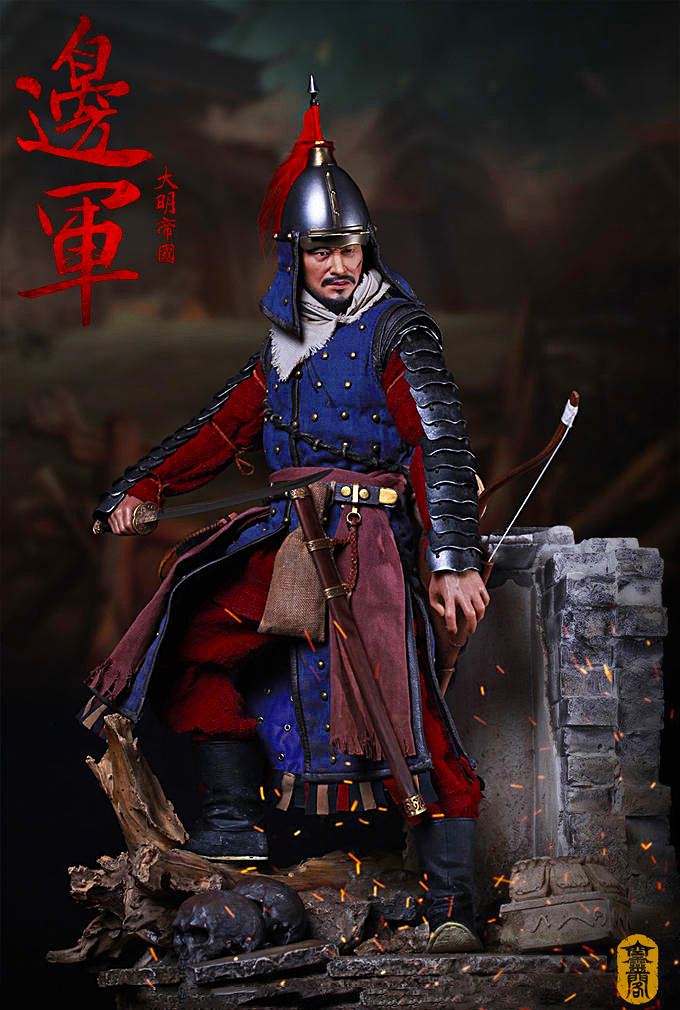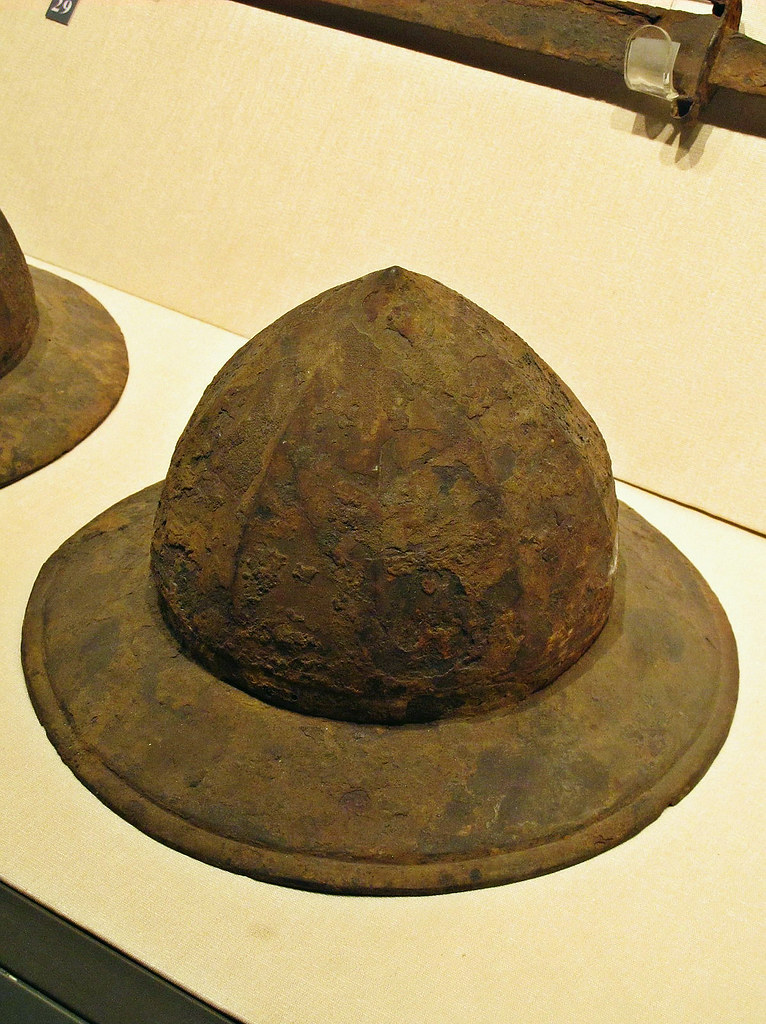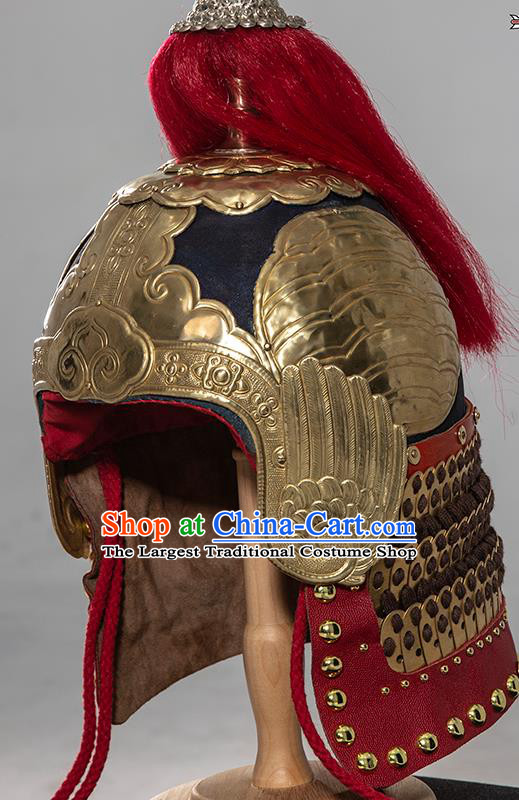
UNIT. Ming Frontier Troops 明邊軍
1 Ancient helmets from the pre-Qin period 2 Dou Mou in the Warring States, Qin and Han Periods 3 Zhou after Wei and Jin 4 Definition and types of Kui The Chinese ancient armor protecting the head was called Zhou (胄, helmet) in the pre-Qin period. In oracle bone inscriptions, the helmet is painted as a shield with a vertical tube at the top.

Iron Helmet of Ming Dynasty 明铁盔 Ming Dynasty(1368-1644) Un… Flickr
Because of its overall form and the style of its ornament, it appears to be an early example of helmet types that are usually associated either with the later part of the Ming dynasty (1368-1644) or the more familiar ceremonial helmets of the Qing dynasty (1644-1911).

Chinese Traditional Ming Dynasty Helmet Hanfu Headwear Ancient General Hat for Men
Zhou dynasty (c. 1046 BC-256 BC) Armour in the Zhou dynasty consisted of either a sleeveless coat of rhinoceros or buffalo hide, or leather scale armour. Helmets were largely similar to Shang predecessors but less ornate. Chariot horses were sometimes protected by tiger skins. [3] helmet fittings (leather helmet no longer extant)

Chinese Ming dynasty Phoenix wing helmet Ancient armor, Ancient warfare, Chinese armor
Learn with Us Research Shop Search The Collection Arms and Armor Helmet Mongolian or Chinese 1350-1450 Not on view Based on its decoration and construction, this helmet appears to date from the late Yuan (1279-1368) to the early Ming dynasty (1368-1644), a period from which surviving armor is very rare.

Antique Chinese late Ming period helmet Chinese armor, Armor, Ancient china
You can tell by the green rust over a near orangish tint that the first helmet is cast of bronze, while the severe rust and coloration of the plates of the second helmet indicates cast-iron. Here's a Ming Dynasty helmet below now found in a museum in Japan, as it was used in the Imjin War of the 1590s, where Joseon (Korea) and Ming (China) were.

Ming Imperial Guard Phoenix Wing Parade Helmet Chinesearmor Chinese armor, Chinese
Ming Dynasty Helmet (1 - 1 of 1 results) Price ($) Any price Under $50 $50 to $250 $250 to $500. Plate arms of Ming dynasty, Bi Fu arms protection,armour of the Ming army, Protection armor Ming,Blackened arms protection,Steel Mastery (234) $ 959.45. Add to Favorites.

Yi Sun Sin, Tibet, Chinese Armor, Knight Armor, Armor Concept, Chinese Clothing, Ancient China
The Ming dynasty, which succeeded the Yuan (Mongol) dynasty (1206-1368), was founded by Zhu Yuanzhang. Zhu, who was of humble origins, later assumed the reign title of Hongwu. The Ming became one of the most stable but also one of the most autocratic of all Chinese dynasties. More From Britannica. China: The Ming dynasty.

Antique Chinese late Ming dynasty helmet 갑옷
For the most part, Chinese soldiers seldom wore specialised arming garments under their armours or helmets, as such equipment are perfectly functional even without underlying padding. Still, most forms of Chinese military clothing seem to be fairly thick or possibly lightly padded, which help to prevent chafing.

Chinese Ming dynasty helmet
The Battle of Sarhū ( simplified Chinese: 萨尔浒之战; traditional Chinese: 薩爾滸之戰; pinyin: Sà'ěrhǔ zhī zhàn) refers to a series of battles between the Later Jin dynasty (the predecessor of the Qing dynasty) and the Ming dynasty and their Joseon allies in the cold winter of 1619.

Chinese Ming Dynasty Warrior Training Chinese armor, Dynasty warriors, Armor
Is there a SINGLE surviving find of Song/Ming Dynasty armor with Mountain Pattern links? Or better yet, an officer's helmet with the winged cheek plates? If not, could you just dump your favorite armor reconstruction/finds? Qing may not apply.

Carl Zha on Twitter "Ming Dynasty helmet with Song Dynasty style armor PS, it’s not me…
Tibetan visor contemporary to the Ming Dynasty, Metropolitan Museum of Art. Helmet visors had been referenced sporadically in Chinese records but never in extensive detail. Many of the unearthed helmet visors which looked like a face were from the Song- Jin wars and were part of heavy cavalry helmets. Art by : 蒸魚葱

Chinese Ming dynasty helmet Chinese armor, Armor, Pendant light
The military of the Ming dynasty was the military apparatus of China from 1368 to 1644. It was founded in 1368 during the Red Turban Rebellion by Zhu Yuanzhang (Hongwu Emperor). The military was initially organised along largely hereditary lines and soldiers were meant to serve in self-sufficient agricultural communities.

Parade helmet of Emperor Wanli (萬曆皇帝), Ming Dynasty. ANTIQUE ARMS&ARMOUR Pinterest Emperor
Also known as Chang Shen Da Jia (長身大甲, lit. 'Long body great armour'), this style of armour is essentially the same as Ming brigandine, except with armour plates on the surface of the coat rather than beneath it. It can be made of bronze or iron, and of either lamellar, scale or mountain pattern construction.

Ming Frontier Troop 明邊軍. Ming border trooper in brigandine armor and arm guards. He wore a
11 wolflance1 • 5 yr. ago So you are the armorer that make the armor? I have several questions for you: why is that your sleeves puff up at the armpits area? why are you using a trident on the helmet? Isn't trident-helmet more of a Korean thing? I've yet to see a Ming helmet with trident, either in art or on actual artefact.

Chinesearmor Arm Armor, Body Armor, Geisha, Renaissance, Chinese Armor, Dynasty Warriors
A notable improvement of Qing armour over its Ming predecessors is the addition of a type of flared cuff known as Ma Ti Xiu (馬蹄袖, lit. 'Horse hoof cuff') to armoured sleeves and vambraces to better protect the hands. Overall, Qing armour offers superior mobility, modularity, and ease of manufacture (as every components of Qing armour.

Antique Chinese Ming dynasty kettle helmet Chinese armor, Ancient china, Chinese
From 14th Century China, The Ming Dynasty is well known for it's finely crafted art (of all kinds). The Dynasty was also well known for equipping it's soldiers with the best (and most innovative) weapons available. Such was The Basic Ming Helmet. Designed for Royal Troops (possibly infantry), The Ming Helmet consisted of 2 components.